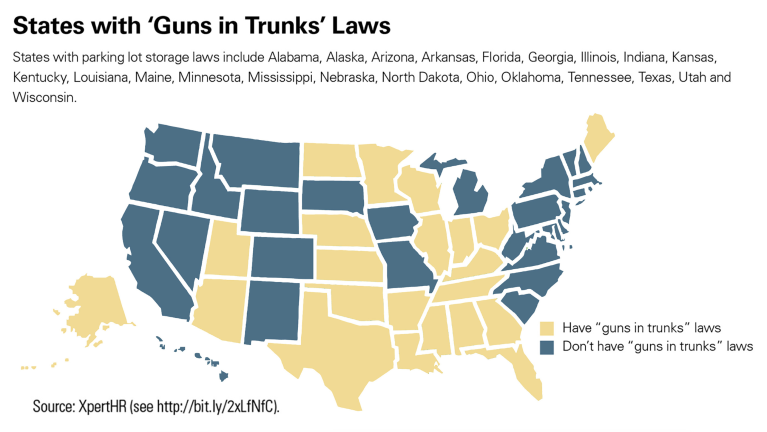Guns in the Workplace
How can HR balance the rights of gun owners with safety in the workplace?

Under the federal Occupational Safety and Health Act, businesses are required to maintain safe workplaces. “Employers take very seriously the importance of making rules for the workplace and establishing a particular tone or culture within its employee teams,” notes John Harrison, an attorney with Ogletree Deakins in Dallas and Nashville, Tenn. Those efforts generally include prohibiting dangerous items like guns and knives as well as disruptive behaviors such as drug use, gambling and fighting.
So how can HR professionals reconcile their workplace safety obligations with employees’ right to bear arms?
Very carefully, experts say.
“On the one hand, firearms are deadly and may contribute to additional violence and fatal injuries,” Harrison says. “On the other hand, the right to bear arms is grounded in the U.S. Constitution, and possession of firearms by licensed citizens may promote individual safety as well as safety in the community.”
Parking Lot Laws
As a compromise solution, about half of the states in the U.S. have passed parking lot, or “guns in trunks,” laws that create limited exceptions to employer policies banning weapons on their property. Such legislation allows employees to store guns in their personal vehicles.
The laws vary in their requirements, but they have a few things in common, including stipulating that the firearm must be:
• Lawfully possessed by the employee.
• Concealed from view.
• Locked in a personal vehicle (e.g., in the trunk or glovebox of an employee’s car).
Many parking lot statutes prohibit firearms from being stored in company-owned vehicles, and none of them grant people the right to carry a gun into an office, notes Andrew Rogers, an attorney with Littler in Tysons Corner, Va.
“No states to date have attempted to create a right for an employee to possess a weapon in the workplace beyond the parking lot,” Harrison explains.
Note that visitors to the property are treated differently than employees under many state laws, he says. Many states allow business owners to prohibit visitors from bringing weapons onto their property. However, Harrison says, business owners must often provide notice of a policy against weapons by a public sign or notice that is conspicuously posted at entrances and public areas. Some states—such as Texas—require specific language, sizes and locations for valid notices.
The Occupational Safety and Health Administration (OSHA) hasn’t weighed in on these laws and has instead deferred to states on the matter, notes Carla Gunnin, an attorney with Jackson Lewis in Atlanta.
Opponents of guns in the workplace have challenged state parking lot laws, and courts have said that OSHA requirements don’t pre-empt them, Harrison explains. So experts advise HR to refer to state laws when developing relevant policies and practices.

What does this mean for workplace safety issues? There’s a litigation risk whenever someone is injured at work, Rogers points out. For one thing, employers may face standard tort liabilities—such as negligence claims—for injuries that occur on their property. They might also have to deal with a negligent hiring claim if an employee acts violently and the employer knew or should have known about the worker’s record of—or propensity for—such dangerous behavior.
That’s why it’s critical to have a clear workplace violence policy that addresses weapons as well as broader safety issues, Rogers says.
The Bigger Picture
The best way for HR professionals to respond to parking lot gun laws is to develop a comprehensive, zero-tolerance workplace violence policy that allows firearms possession and storage only as required by law, Rogers says.
But don’t limit your policy to firearms. Rogers suggests that employers assess their facilities and determine how to make their workplaces more secure overall. For example, make sure your parking lot has adequate lighting and monitor who has access to the building. And when workers’ employment is terminated, promptly deactivate their access cards.
“It is important to have a policy in place, but employers also have to take the next steps,” Rogers says. “The piece of paper doesn’t enhance your security unless you are addressing broader safety issues in the workplace.”
[SHRM members-only policy: Weapon-Free Workplace Policy]
Best Practices
Be careful to comply with each state’s specific laws and take additional steps—such as conducting background checks, making emergency-plan preparations and leading prompt investigations—to promote a safe workplace, Harrison says.
And remember that a workplace violence policy should focus, first and foremost, on employee behavior. “Workplace violence goes beyond weapons and can include verbal assaults and other threatening behavior,” Gunnin says.
Sometimes businesses develop policies in reaction to an event—but that’s not a good practice, she says. It’s better to implement clear guidelines before ever encountering a problem and to provide comprehensive training on company protocol so supervisors know how to handle any situations that may arise, she says. This is one instance where it’s far better to be safe than sorry.
Lisa Nagele-Piazza, SHRM-SCP, J.D., is senior legal editor for SHRM.
Was this article useful? SHRM offers thousands of tools, templates and other exclusive member benefits, including compliance updates, sample policies, HR expert advice, education discounts, a growing online member community and much more. Join/Renew Now and let SHRM help you work smarter.
An organization run by AI is not a futuristic concept. Such technology is already a part of many workplaces and will continue to shape the labor market and HR. Here's how employers and employees can successfully manage generative AI and other AI-powered systems.



